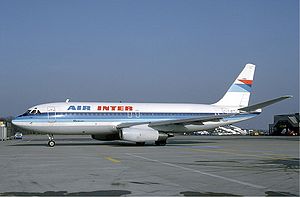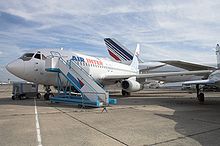- Dassault Mercure
-
Mercure Air Inter Mercure at Basle, February 1985 Role Narrow-body jet airliner Manufacturer Dassault Aviation First flight 28 May 1971 Retired 29 April 1995 Primary user Air Inter Produced 1971-1975 Number built 12 The Dassault Mercure was a French twin-engined jet-powered airliner. It was proposed in 1967, first production flight was in 1973 and last flew in 1995.
Contents
Design and development
In 1967, backed by the French government, Dassault decided to propose a competitor to the Boeing 737. This would attack this market segment by the upper end, with a 140-seat jetliner, compared to the 100-seat -100 and the 115-seat -200 Boeing 737 variants then in production. This aircraft would be an opportunity for Dassault to show the civilian market its knowledge of high-speed aerodynamics and low speed lift capability previously developed by producing a long line of jet fighters, such as the Dassault Ouragan, Dassault Mystère and Dassault Mirage aircraft.
Marcel Dassault, founder and owner of Dassault, decided to name the aircraft Mercure (French for Mercury). "Wanting to give the name of a god of mythology, I found of them only one which had wings with its helmet and ailerons with its feet, from where the Mercure name.." Marcel Dassault said.[1] Extremely modern computer tools for the time were used to develop the wing of the Mercure 100. Even though it was larger than the Boeing 737, the Mercure 100 was the faster of the two. In June 1969, a full scale mock-up was presented during the Paris Airshow at Le Bourget airport. On 4 April 1971, the prototype Mercure 01 rolled out of Dassault's Bordeaux-Merignac plant.[2] It was powered by two Pratt & Whitney JT8D-11 (6800 kg of thrust). The first flight took place in Merignac on 28 May 1971.[3] The second prototype, which was powered by two Pratt & Whitney JT8D-15 (the engine which would be used on all subsequent Mercure built), flew for the first time on 7 September 1972.[4] On 19 July 1973, the first production aircraft made its maiden flight. The Mercure received its Type certificate on 12 February 1974, and on 30 September 1974, was certified for Category IIIA approach all-weather automatic landing (minimum visibility = 500 ft, minimum ceiling = 50 ft).[5] The Mercure 100 was also the first commercial airliner to be operated by a 100% female crew on one of its flights.[1]
Dassault tried to attract the interest of major airlines and several regional airlines, by touting the Mercure 100 as a replacement for the Douglas DC-9. A few airlines showed some initial interest but only Air Inter, a domestic French airline, placed an order. This lack of interest was due to several factors, including the devaluation of the dollar and the oil crisis of the 1970s, but mainly because of the Mercure's operating range – suitable for domestic European operations but unable to sustain longer routes. At maximum payload, the aircraft's range was only 1,700 km. Consequently, the Mercure 100 achieved no foreign sales. With a total of only 10 sales with the one of the prototypes refurbished and sold as the 11th Mercure to Air Inter, the airliner represents the worst failure of a commercial airliner in terms of aircraft sold. The number of sales is less than other poor selling aircraft such as the Concorde (14 produced, 20 including prototypes and preproduction aircraft), the VFW-Fokker 614, Convair 880 and 990, Vickers VC-10, Tupolev Tu-144 and the Boeing 747SP.
After the commercial failure of the Mercure 100, Marcel Dassault asked his engineers to develop a new version of the Mercure, the Mercure 200C in cooperation with Air France, it was to carry 140 passengers with a range of 2,200 km. Several major airlines in the United States showed some interest in the project. However, the project design costs were also high. This might have been mitigated if the original Mercure had a larger fuel capacity or sufficient design strength so that additional fuel tanks could have been easily added.[citation needed]
At the beginning of 1973, an agreement was created with the French government to finance this programme. Dassault was to receive a loan of 200-million French Francs from the French government, which would be paid back based on sales after the 201st aircraft was delivered. But Air France wanted an airliner powered with the Pratt & Whitney JT8D-117, which was quieter and larger than the JT8D-15. Dassault needed an additional loan of 80-million French Francs from the government to accommodate Air France's request. The French government replied to Dassault that it had to carry half of the development costs of the Mercure 200C on their own, which was impossible after the commercial failure of the Mercure 100. The Mercure 200C project was then canceled.
Later, in order to answer a request from the DGAC (Direction Générale de l'Aviation Civile, the French civil aviation authority), Dassault proposed a Mercure equipped with a new engine developed by General Electric/Snecma called the CFM-56; this version came to be known as the Mercure 200. In 1975, contacts were made with Douglas and Lockheed to build and sell the Mercure 200 in the US, and with SNIAS to build it in France. But Marcel Dassault was concerned about the fact that the CFM-56 had not had a single order yet, and production might end produced before the Mercure 200 could be built. Meanwhile, Douglas introduced a stretched version of the DC-9, which was in direct competition for orders with the Mercure 200. Contacts with Douglas logically ended at that point. Dassault then initiated contacts with General Dynamics, their primary competitor in the military jet market where the Mirage F1 was facing the F-16 Fighting Falcon.[citation needed] Nothing would come out of these contacts.
Operational history
Hoping for mass production of the Mercure (the 300th aircraft was planned to be delivered by the end of 1979), with Break-even hoped for after 125-150 aircraft.[6] Dassault created four plants especially for the Mercure program: Martignas (close to Bordeaux), Poitiers, Seclin (close to Lille) and Istres.[7] On January 30, 1972, Air Inter ordered 10 Mercures, which had to be delivered between 30 October 1973 and 13 December 1975.[citation needed] Due to the lack of other orders, the production line was shut down on 15 December 1975. Only a total of two prototypes and 10 production aircraft were built. One of the prototype (number 02) was eventually refurbished and purchased by Air Inter to add it to its fleet.[4]
Canadair was one of a few sub-contractors involved in the early development of the Mercure.
On 29 April 1995, the last two Mercures in service flew their last commercial flight. All Mercures are now retired with an impressive history: 360,000 flight hours, 44 million passengers carried in 440,000 flights, no accidents, and a 98% in-service reliability.
Operator
- Air Inter
- Ecole Supérieure des Métiers de l'Aéronautique used fifth produced Mercure (registered F-BTTE and painted in fictional Air Littoral colours), as a ground instructional airframe.
Specifications
General characteristics
- Crew: 3: pilot, co-pilot and flight engineer
- Capacity: 150 passengers
- Length: 34.84 m (114 ft 3 in)
- Wingspan: 30.55 m (100 ft 3 in)
- Height: 11.35 m (37 ft 4 in)
- Wing area: 116 m² (1,248 ft²)
- Empty weight: 31,800 kg (69,960 lb)
- Max takeoff weight: 56,500 kg (124,300 lb)
- Powerplant: 2 × Pratt & Whitney JT8D-15 turbofans, 68.9 kN (15,500 lbf) each
Performance
- Maximum speed: 925 km/h (499 knots, 578 mph)
- Cruise speed: 870 km/h (470 knots, 540 mph)
- Range: 1,756 km (920 nm, 1100 mi)
- Service ceiling: 12,000 m (39,000 ft)
- Rate of climb: 16.7 m/s (3,300 ft/min)
- Takeoff roll: 2,750 m (9,000 ft)
- Landing roll: 1,650 m (5,400 ft)
See also
- Aircraft of comparable role, configuration and era
- Related lists
- List of airliners
References
- Notes
- ^ a b "CAEA: Mercure 100." Conservatoire de l'Air et de l'Espace d'Aquitaine (CAEA). Retrieved: 21 June 2009.
- ^ Flight International 22 April 1971, p. 539.
- ^ Uijthoven 2005, p. 70.
- ^ a b Uijthoven 2005, p. 73.
- ^ Taylor 1976, p. 56.
- ^ Middleton, Flight International 20 May 1971, p. 721.
- ^ Middleton, Flight International 20 May 1971, p. 724.
- Bibliography
- "Air Transport". Flight International. 22 April 1971. pp. 538–540.
- Middleton, Peter. "Dassault Mercure". Flight International, 20 May 1971, pp. 721–726.
- Taylor, John W. R. Jane's All The World's Aircraft 1976-77. London: Jane's Yearbooks, 1976. ISBN 0-354-00538-3.
- Uijthoven, René L. "An 'Airbus' Before Its Time:Dassault's Mercure Airliner". Air Enthusiast, No. 115, January/February 2005, pp. 70–73. Stamford, UK:Key Publishing.
Dassault Aviation aircraft Numeric Military Alpha Jet · Balzac V · Étendard II · Étendard IV · Flamant · Mirage III · Mirage IIIV · Mirage IV · Mirage 5 · Mirage 50 · Mirage F1 · Mirage F2 · Mirage G · Mirage 2000 · Mirage 4000 · Mystère I · Mystère II · Mystère III · Mystère IV · nEUROn · Ouragan · Rafale · Spirale · Super Étendard · Super Mystère
Civil Communauté · Hirondelle · Mercure · Mystere 10 · Mystere 20 · Falcon 10 · Falcon 20 · Falcon 30 · Falcon 50 · Falcon 100 · Falcon 200 · Falcon 900 · Falcon 2000 · Falcon 7X ·
Lists relating to aviation General Aircraft (manufacturers) · Aircraft engines (manufacturers) · Airlines (defunct) · Airports · Civil authorities · Museums · Registration prefixes · Rotorcraft (manufacturers) · TimelineMilitary Accidents/incidents Records Categories:- Dassault aircraft
- French airliners 1970–1979
Wikimedia Foundation. 2010.



